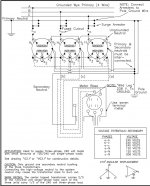schellersp
Member
- Location
- Manchester, TN
- Occupation
- Journeyman Lineman
We recently had an incident that I was hoping someone could help shed some light on. We have three single phase transformers connected wye on the high side delta on the load side. 50 kva center pot with 25 kva wing pots serving three phase power to a restaurant and twin single phase residences. We had disconnected the three phase service so they could do some work at the restaurant leaving only the single phase load connected. About 4 hours after the three phase load was disconnected the A phase transformer blew the the lid off. We replaced A and B phase transformer and re-energized the transformer bank. While checking voltage at the residence the voltage started out normal 120/240 and it continued to rise. We opened the bank back up left the wing pots open and tied down the H2 bushing and re-energized the B phase transformer to serve the single phase load. Is it possible that with no three phase load connected that a circulating current existed in the floated high side that induced more voltage in the secondary? We don’t know if it was just coincidence that the transformer blew when it but don’t understand why the voltage continued to rise after the transformer bank was rebuilt. After the restaurant is reconnected, if they open their main breaker for some reason is it going to cause the high voltage again? Thanks


